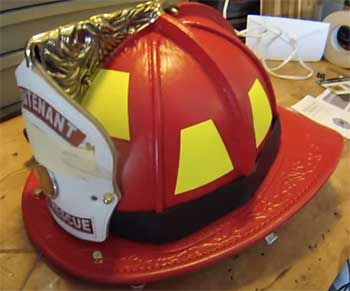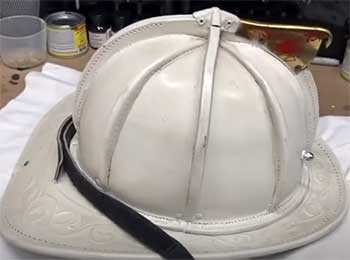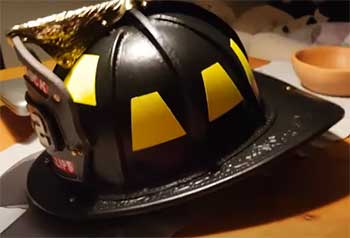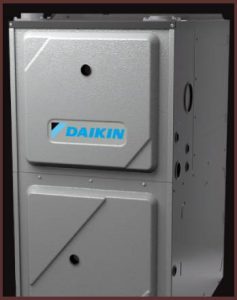When it comes to choosing protective equipment, firefighters know that their lives depend on making the right choice. A structural firefighting helmet is one of the most important pieces of personal protective equipment, protecting the head from impact, heat, and flames.
Two popular helmets used by fire departments across North America are the Phenix TL-2 and Cairns N5A. But how do you decide which one is the better option for your department?
In this comprehensive guide, we’ll compare the key features, pros and cons, and important considerations for both the Phenix TL-2 and Cairns N5A structural firefighting helmets.
Whether you’re equipping a whole department or selecting your own helmet as a firefighter, this detailed comparison will help you make an informed decision.
A Brief Comparison Table
| Feature | Phenix TL-2 | Cairns N5A |
| Shell Material | Leather | Fiberglass composite |
| Suspension System | Bourkes web ratchet | Advanced ratchet |
| Impact Protection | Effex multilayer liner | EnergyCap liner |
| Heat Resistance | Up to 350°F | Up to 350°F |
| Weight | 4.5 – 5 lbs | 3.6 – 4.2 lbs |
| Accessories | Shields, goggles, lights | Modular accessories |
| Price | $234 – $254 | $279 – $329 |
| Pros | Classic leather, affordable price | Lightweight, maximum impact protection, modular design |
| Cons | Heavy, fewer accessories | More expensive, non-traditional material |
Overview of the Phenix TL-2 Helmet
The Phenix TL-2 is a traditional leather helmet that meets the NFPA 1971 standards for structural firefighting. It has a classic leather shell with a Bourkes retention system and Effex thermoplastic liner.
Some of the key features and benefits of the Phenix TL-2 include:

- Traditional leather shell – The outer shell is made from durable, heat-resistant leather. Leather shells are moisture-resistant and strong while still allowing for ventilation.
- Bourkes retention system – This ratchet-adjustable headband provides a secure, custom fit for each firefighter. It distributes weight comfortably while still keeping the helmet firmly in place.
- Effex thermoplastic liner – The multi-layer liner incorporates Effex thermoplastic pads that are heat-resistant up to 350°F. This protects the firefighter’s head from high temperatures.
- Earcups and front brow pad – For added comfort, earcups cushion the ear areas while the front brow pad protects the firefighter’s forehead.
- Customizable options – Helmet shields, goggles, lamps, and other accessories can be added for specialized tasks. Custom front plates allow for department branding.
- Meets NFPA 1971 standards – The TL-2 model is certified as compliant with the latest NFPA requirements for structural firefighting helmets.
The Phenix TL-2 provides a traditional leather helmet option with important safety features and customization. The leather shell is durable in fireground conditions while the Effex liner protects from extreme heat. It’s a solid choice for those who prefer a classic leather helmet.
Overview of the Cairns N5A Helmet
The Cairns N5A is a modern composite helmet that also meets the NFPA 1971 standards for structural firefighting. It features a composite shell, ratchet headband, and impact liner system.
Here are some of the key features and benefits of the Cairns N5A:

- Fiberglass composite shell – The outer shell is made from fiberglass composite material that is lightweight yet durable. The composite material is heat and impact-resistant.
- Easy-adjusting headband – A ratchet adjustment system and adjustable headband provide a secure yet comfortable fit for a wide range of head sizes.
- Advanced impact liner – The EnergyCap liner includes multiple layers of advanced impact-absorbing materials to cushion against blows.
- ReTrak earflaps – Unique flexing earflaps provide protection while allowing customized positions.
- Modular design – The brim, earflaps, front brow pad and other parts are removable and replaceable as needed. Accessories can be added.
- NFPA 1971 compliant – The N5A model meets the latest NFPA standard for structural fire helmets.
The Cairns N5A offers a high-tech composite helmet solution with outstanding impact protection and heat resistance. The modular design provides customization options for specialized tasks or accessories.
Key Differences Between Phenix TL-2 And Cairns N5A Helmets
Now, let’s take a close look at how the Phenix TL-2 and Cairns N5A stack up against each other in key categories:
Shell material
- Phenix TL-2: Leather shell
- Cairns N5A: Fiberglass composite shell
The TL-2 has a traditional leather material while the N5A uses lightweight fiberglass composite. Leather is moisture-resistant but composite is more durable.
Suspension and fit
- Phenix TL-2: Bourkes web suspension with ratchet adjustment
- Cairns N5A: Advanced ratchet suspension with adjustable headband
Both offer adjustable ratchet systems for a secure custom fit. The N5A may have a bit more flexibility for fit.
Impact protection
- Phenix TL-2: Multi-layer Effex thermoplastic liner
- Cairns N5A: EnergyCap advanced impact liner system
The N5A liner provides top-of-the-line impact cushioning and absorption. The TL-2 still provides solid impact protection.
Heat resistance
- Phenix TL-2: Effex liner rated up to 350°F
- Cairns N5A: Composite shell rated up to 350°F
Again, both meet standards for high-heat resistance during firefighting activities.
Weight
- Phenix TL-2: 4.5 to 5 lbs
- Cairns N5A: 3.6 to 4.2 lbs
The N5A is slightly lighter than the TL-2 thanks to the composite shell. This helps reduce neck fatigue.
Accessories
- Phenix TL-2: Shields, lamps, goggles available
- Cairns N5A: Full line of modular accessories
Both have accessory options but the N5A may have more flexibility for customization due to its modular parts.
Price
- Phenix TL-2: $234 to $254
- Cairns N5A: $279 to $329
The TL-2 is more affordably priced while the N5A costs more for its advanced features.
As you can see, while both helmets offer excellent protective qualities, the Cairns N5A generally provides more leading-edge features and options. But the Phenix TL-2 is a time-tested design at a more budget-friendly price point.
Key Factors To Consider
Your department’s specific needs and preferences should drive your final decision between these two helmets. Here are some key factors to consider:
- Budget – The Phenix TL-2 is more affordable while providing the required safety. If budget is a major factor, it may be the ideal choice.
- Helmet style preferences – Some firefighters strongly prefer traditional leather helmets. Others like the modern look of composite.
- Head protection needs – The Cairns N5A offers maximum impact absorption if this is a priority.
- Use of accessories – The N5A’s modular design enables extensive accessories for special tasks.
- Weight preferences – The lighter N5A helmet may appeal if reducing neck fatigue is important.
- Heat resistance needs – Both meet NFPA standards, but if your firefighters face ultra-high temps, analyze the materials used.
Consider these factors along with the comparison information above as you determine the right structural fire helmet for your needs.
Pros and Cons of Phenix TL-2 and Cairns N5A
To summarize the key advantages and disadvantages of each helmet:
Phenix TL-2 Pros

- Classic leather firefighter helmet design
- Durable and moisture-resistant leather shell
- Meets all NFPA 1971 standards
- Bourkes retention system for secure fit
- Reasonable price point
Phenix TL-2 Cons
- Heavier than composite helmets
- Not as many accessory options as modular helmets
- Leather requires more cleaning maintenance
- Less impact cushioning than Cairns N5A
Cairns N5A Pros
- Lightweight yet durable fiberglass composite shell
- Advanced impact absorption with EnergyCap liner
- Fully modular design for accessories and customization
- State-of-the-art ratchet suspension for secure fit
- Excellent heat resistance
Cairns N5A Cons
- More expensive price point
- Composite material lacks the traditional appeal of leather
- ReTrak earflaps may be tricky for some users
- Not as cost-effective if accessories are not needed
As you can see, both options have their own pros and cons. The right choice depends on your specific needs and preferences.
Also Read: Comparison of Smith Nexus And Vantage Helmets.
Frequently Asked Questions (FAQ)
The main difference between the Cairns N5A and N6A structural firefighting helmets is their brim design. The N5A has a tapered brim that slopes downwards, while the N6A has a flat brim all the way around. Some firefighters prefer the angled brim of the N5A for better visibility looking upwards. But the N6A’s flat brim offers more sun and debris protection all around. Both versions meet NFPA 1971 standards and have similar materials, liner systems, and features otherwise.
Yes, the Cairns N5A helmet is certified as compliant with the NFPA 1971 standard for structural firefighting helmets. It meets or exceeds all the NFPA requirements for impact resistance, heat resistance, water resistance, and other protective criteria. The N5A model has passed independent laboratory testing to receive NFPA 1971 certification.
The Cairns N5A weighs between 3.6 and 4.2 pounds, depending on the shell size you select. Here are the weights by shell size:
1. Size 6 3⁄4 – 3.6 lbs
2. Size 7 1⁄4 – 3.8 lbs
3. Size 7 3⁄4 – 4 lbs
4. Size 8 – 4.2 lbs
This makes the N5A lighter than traditional leather helmets. The lightweight fiberglass composite shell helps reduce fatigue on firefighters’ necks and shoulders compared to heavier helmets.
The large size of the Cairns N5A structural fire helmet corresponds to a shell size of 7 3⁄4. Here are the shell sizes for each N5A fit:
1. Small: Size 6 3⁄4
2. Medium: Size 7 1⁄4
3. Large: Size 7 3⁄4
4. Extra Large: Size 8
To determine your correct N5A size, you’ll need to carefully measure your head’s circumference. The interior of the Size 7 3⁄4 shell will fit heads that measure between 23 1/8 and 23 5/8 inches around. Refer to a Cairns sizing chart for full recommendations based on your head measurement.
Final Thoughts
Selecting the right structural firefighting helmet requires careful consideration of many factors – your budget, feature needs, priorities, and individual preferences all play a role.
While both the Phenix TL-2 and Cairns N5A are high-performing NFPA-compliant options, the Cairns N5A offers more advanced technology and customization. But the TL-2 can’t be beaten on traditional leather style and value.
Weigh the pros and cons, key comparison points, and buying factors outlined above. Try on different helmets to judge comfort and fit. And select the model that best matches your department’s needs and protects the life and safety of each firefighter.
Investing in high-quality helmets for your team ensures you have the crucial head protection that your dangerous jobs demand. Stay safe out there!




Where did you find that N5A is NFPA1971 compliant?